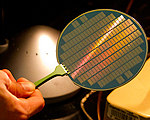First Nanotube Computer
 Oct-01-13
Researchers have built a basic computer using carbon nanotubes, potentially opening the door to a new generation of faster, more efficient electronic devices.
Oct-01-13
Researchers have built a basic computer using carbon nanotubes, potentially opening the door to a new generation of faster, more efficient electronic devices.A team from Stanford University built the rather basic computer, which contains 178 carbon nanotube transistors and operates on only one bit of information. Compared to the billions of silicon-based switches and 64-bit machines of today, the nanotube computer is rather primitive. However, the discovery is significant in that transistors seem to be reaching their minimal size limits.
Nanotubes have been difficult to incorporate into consumer electronics because they tend to grow slightly misshapen and some of them are always on, so are always conducting. To create carbon nanotubes that could be used in electronics, the team had to first develop an algorithm that would allow them predict how the less-than-straight nanotubes would work on a circuit. Then, to deal with the 'always-on' problem, they added all the nanotubes to a circuit and turned off the properly functioning nanotubes. This led to the electricity burning up the always-on nanotubes and leaving only the proper ones behind.
More Info about this Invention:
[STANFORD.EDU][IEEE]

Add Your Comment